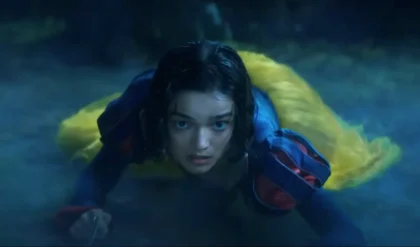Though Monsters: The Lyle and Erik Menendez Story centers on the titular brothers’ sensationalized murder trial, Netflix’s true-crime miniseries touches on several other high-profile murder cases. One of these cases is the tragic 1982 murder of actress Dominique Dunne. Following the Poltergeist star’s death, her father Dominick Dunne went on to write about several crime sagas for Vanity Fair, including one on the murders of José and Kitty Menendez. Episode 7 of Monsters, named “Showtime,” follows the writer as he attends the Menendez trial while still struggling with his daughter’s death, which tinged his coverage of the brothers.
As millions of viewers tune in to the new series created by Ryan Murphy and Ian Brennan, many are left wondering about the life of Dominique Dunne, and why her case and Dominick’s writing looms large over the fictionalized true-crime story. Read on to learn more about Dominick Dunne.
Dominick Dunne was a Hollywood producer who became an acclaimed true-crime writer.
Dominick Dunne was born in Hartford, Connecticut in 1925, and graduated from Williams College in 1949, after serving in World War II. After college, Dunne moved to N.Y.C., where he began his television career before eventually moving to Hollywood. He served as a producer on several films, including 1970’s The Boys in the Band and 1971’s The Panic in Needle Park—the latter being a collaboration with his younger brother John Gregory Dunne and sister-in-law Joan Didion.
Despite his successful Hollywood career, Dunne moved from L.A. to rural Oregon in 1979, where he sought treatment for his alcohol addiction. In the wake of his daughter’s tragic 1982 death, Dunne transitioned to writing about crime and society throughout the ’80s and published 11 books based on real-life crimes. He also hosted the talk show Dominick Dunne’s Power, Privilege, and Justice on Court TV (later truTV) from 2002 until his death from bladder cancer in 2009.
As for his personal life, Dominick married ranching heiress Ellen Griffin in 1954. The couple welcomed five children: actors Griffin Dunne and Dominique Dunne, Alexander Dunne, and two daughters who died in infancy. Dominick and Ellen later divorced in 1965. Ahead of his death, in a 2009 interview with The Times of London, Dominick described himself as a “closeted bisexual celibate.”

Dominick Dunne (played by Nathan Lane) regales his dinner guests with his theories on the Menendez case in Monsters: The Lyle and Erik Menendez Story.
(Image credit: Miles Crist/Netflix)
Dominick Dunne’s daughter Dominique Dunne was a rising actress on the brink of stardom.
Dominique Dunne was born in November 1959, the youngest child of Dominick Dunne and Ellen Griffin Dunne. After growing up with a parent and several relatives in showbiz, including Didion and godmother Maria Cooper, Dominique started acting. Her first role was in the 1979 TV movie Diary of a Teenage Hitchhiker, and she went on to have supporting roles in popular ’80s TV series like Breaking Away, Hart to Hart, CHiPs, and Hill Street Blues.
Dominique’s big break came with her supporting role as Dana Freeling, the eldest child of a family tormented by demonic spirits, in the 1982 horror film Poltergeist. The movie was praised by critics at release and grossed over $77 million at the box office, per IMDb. However, Dominique tragically died before production began on its sequel Poltergeist II: The Other Side. V, a miniseries she was filming before she died, was released in 1983 in her memory.
Dominique Dunne was murdered by her ex-boyfriend John Sweeney, who served little prison time.
At a 1981 party, Dominique Dunne met John Thomas Sweeney, a sous chef at the glamorous L.A. eatery Ma Maison. According to a 1983 PEOPLE article, the couple felt a quick and strong attraction, and within “a few weeks” they had rented a house together. However, they soon faced difficulties, which the outlet attributed to “differences of temperament and schedules sharpened by the contrast between their backgrounds.” Sweeney grew up in a Pennsylvania coal town to an alcoholic, physically abusive father, before taking a bus to L.A. at age 20 and working his way up the ranks at elite restaurants, including serving as a chef’s assistant to Wolfgang Puck.
The couple’s relationship became abusive, with Sweeney reportedly exhibiting controlling behavior, including following Dunne to her horse-riding and acting classes and even on set. His possessiveness and jealousy would lead to long “bitter” arguments. In a letter to him, Dunne wrote, “You do not love me. You are obsessed with me. The person you think you love is not me at all. It is someone you have made up in your head. I think we only fight when images of me fade away and you are faced with the real me… The whole thing has made me realize how scared I am of you.”
By August 1982, their fighting escalated to violence, including one fight where Sweeney tore Dunne’s hair out at the roots and another where he strangled her, with the fight only broken up by a friend staying with them. After that strangling, Dunne ended things and hid out at a friend’s and her mother’s house while he frantically searched for her. Several days later, she convinced him to move out of their shared house, and after she did so, he changed the locks.
On the evening of October 30, 1982, Sweeney arrived at Dunne’s door unannounced, as she was rehearsing a scene with fellow actor David Packer. Dunne went out onto the front porch, and Packer soon heard loud noises and screams. After calling the police (who said the house was outside of their jurisdiction) and a friend, Packer went outside to find Sweeney crouching in the driveway. Sweeney reportedly told Packer to call the police, and once they arrived, Sweeney told them, “I killed my girlfriend, and I tried to kill myself.” Dunne’s heart was stopped when she arrived at the hospital, but by the time she was revived, her brain was no longer functioning. Five days later, her family consented to turn off her life support.

Dominick Dunne attends the Menendez trial in Monsters: The Lyle and Erik Menendez Story.
(Image credit: Courtesy Of Netflix)
Sweeney was charged with first-degree murder, which could result in 25 years to life in prison. During the trial, he claimed that he exploded in anger after Dunne said she did not want to get back together with him and that she had been “leading him on” about reconciling for days. (Per PEOPLE, there was no evidence of a reconciliation besides Sweeney’s claims.) Meanwhile, prosecutors concluded that Sweeney must have choked Dunne for a full five minutes and that he had plenty of time to “come to his senses” and spare her life. Sweeney also reportedly told a cop on the way to the station, “I can’t believe I did something that will put me behind bars forever… Man, I blew it. I killed her. I didn’t think I choked her that hard. I just kept on choking her.”
Ahead of the trial, prosecutors discovered that Sweeney had brutally beaten an ex-girlfriend, Lillian Pierce, on 10 separate occasions, once putting her in the hospital. However, the defense managed to keep Pierce’s testimony out of the trial. Not knowing Sweeney’s history, the jury found him guilty of voluntary manslaughter. He was sentenced to just six and a half years in prison, of which he served two and a half.
Dominick Dunne and the Dunne family struggled with the outcome of Dominique’s case for years.
As seen in episode 7 of Monsters, Dominick Dunne had an outburst in court when the judge told the jury that they had “served justice well,” interjecting, “Not for our family.”
Over the years following Sweeney’s sentencing, the Dunne family responded in different ways. Her mother Ellen went on to found the victims’ rights organization Justice for Homicide Victims; in 1989, she was honored by then-president George H.W. Bush at the White House for her work. Dominick wrote the acclaimed article “Justice: A Father’s Account of the Trial of his Daughter’s Killer” for Vanity Fair‘s March 1984 issue.
After Sweeney was released from prison, he was hired as a head chef at a Santa Monica restaurant. Per PEOPLE, Dominique’s family protested outside of the eatery after his hiring, handing out flyers that read, “The food you will eat tonight was cooked by the hands that killed Dominique Dunne.” After the protests, Sweeney quit and left L.A. for Florida, eventually changing his name to John Maura.
In a 2007 Slate article, Dunne admitted that when Sweeney was released from prison, the writer hired private investigator Anthony Pellicano to help Dunne put a hit out on his daughter’s killer’s life. “I was nuts at that time with rage and hate… I truly went through a period of wanting to hire somebody,” Dunne told the outlet. “I know, it seems absurd now… But I worshipped my daughter. I just became obsessed with this guy getting out of prison. I wanted harm to come to him.” However, Pellicano talked him out of it and instead kept track of Sweeney for some years, until the pair terminated their contract. By the time of the Menendez case, Dunne had lost track of Sweeney.
Dominick Dunne covered the high-profile murder trials of Lyle and Erik Menendez, O.J. Simpson, and others.
Following Dominique’s death and the success of “Justice,” Dunne dedicated his career to covering high-profile crime cases. Some of the trials he covered included the murder of Alfred Bloomingdale’s mistress, Vicki Morgan; the rape trial of William Kennedy Smith; the fatal shooting of William Woodward, Jr. by his wife Ann Woodward (which was briefly depicted in Murphy’s Feud: Capote vs. the Swans); and the murder trial of Phil Spector. As seen in Monsters, he was one of two journalists granted full access to O.J. Simpson’s murder trial, a few years after the Menendez brothers; in 2008, at the age of 82, Dunne traveled to Las Vegas to cover Simpson’s trial on kidnapping and armed robbery.
Earlier this year, Griffin Dunne published his memoir, The Friday Afternoon Club: A Family Memoir about the Dunne family’s history. Speaking to PEOPLE about his father’s journalism, Griffin described Dominick as “not a terribly unbiased” journalist. “If he wrote about Phil Spector, he talked about Lana Clarkson and not as a third-rate actress, as the media continue to describe her,” Griffin said. “Or during O.J., he sat with the Browns and Nicole’s family… he always looked at it from the rights of the victim.”

Lyle Menendez (Nicholas Chavez) and Erik Menendez (Cooper Koch) sit in their trail in Monsters: The Lyle and Erik Menendez Story.
(Image credit: Miles Crist/Netflix)
Dominick Dunne helped make Lyle and Erik Menendez’s case a nationwide sensation.
Dominick Dunne and the Dunne family had no connection to the Menendez family before the murders, but in covering the case, he became a definitive voice of the trial that influenced the public opinion of Lyle and Erik Menendez. Millions of Americans interested in the trial turned to media like Dunne’s Vanity Fair articles and the case’s CourtTV coverage to learn everything they could about the Menendez family.
As seen on the show, Dunne’s articles on the case were typically biased towards the prosecution, and likely biased by his previous experience with Sweeney’s trial. In depicting Dunne’s side of the story, Monsters provides a perspective on the Menendez murders filled with doubt about the boy’s motives, one where critics can argue whether or not it was necessary to provide a full picture of the case.











